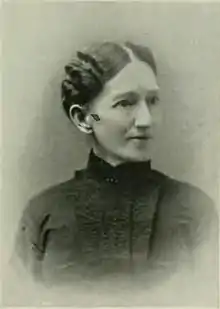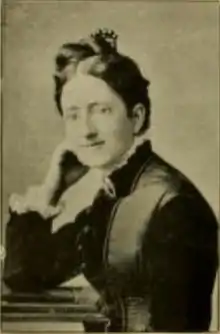Elizabeth Otis Dannelly
Elizabeth Otis Dannelly (June 13, 1838 – March 21, 1896) was an American Southern poet. Born in Georgia, she wrote, Cactus, or Thorns and Blossoms and Wayside Flowers.[1]
Elizabeth Otis Dannelly | |
|---|---|
 "A woman of the century" | |
| Born | Elizabeth Otis Marshall June 13, 1838 Monticello, Georgia, U.S. |
| Died | March 21, 1896 (aged 57) Dallas, Texas, U.S. |
| Resting place | Oakland Cemetery, Dallas, Texas, U.S. |
| Occupation | poet |
| Language | English |
| Nationality | American |
| Alma mater | Emory College, Madison Female College |
| Genre | Southern poetry |
| Notable works | "Destruction of the City of Columbia, South Carolina" |
| Spouse | Francis Olin Dannelly
(m. 1862; died 1880) |
| Relatives | Oliver Hazard Perry, Elisha Dyer |
Early years and education
Elizabeth Otis Marshall was born in Monticello, Georgia, June 13, 1838.[2] Her father, Jackson Marshall, was a native of Augusta, Georgia. On her mother's side, she descended from an old Huguenot family named Grinnell. Her grandfather, Peter Grinnell, was closely connected with Henry Grinnell, of Arctic expedition fame, and was also a first cousin to Oliver Hazard Perry. Her grandmother was a daughter of Anthony Dyer, uncle of Elisha Dyer, Governor of Rhode Island.[3]
While quite young, her father moved to Oxford, Georgia, the seat of Emory College, where her early education was begun. At the age of twelve years, she was sent to school in Charleston, South Carolina, and from that city she entered the Madison Female College, Madison, Georgia, from which institution she was graduated July 26, 1855.[4] Immediately after receiving her diploma, Dannelly went to New York City, where one year was spent in studying painting.[3]
Career
During Dannelly's removal to New York City, her father had moved from Savannah to Madison. In Madison, on September 4, 1862, she married Dr. Francis Olin Dannelly (1823-1880), the son of Rev. James Dannelly, Methodist minister of South Carolina. Dr. Dannelly was, at the time of his marriage, a surgeon in the Confederate army, stationed in Richmond, Virginia. Shortly after, he was ordered to Columbia, South Carolina, where they continued to reside until the close of the American Civil War. About that time, Dannelly wrote her famous seventeen-page poem, "Destruction of the City of Columbia, South Carolina",[5] which was especially prized in the South and added to the popularity of her volume of poems, Cactus, or Thorns and Blossoms (New York, 1879).[3]
Soon after the close of the war, the Dannelly family removed to Baltimore, Maryland, where her husband resumed the practice of medicine, having attained distinction in that occupation. During the years of her residence in Baltimore, Dannelly occupied a leading social position, while being a frequent contributor to many of the leading periodicals and magazines of that day. [3]
With magical skill, could design;
No power can fade, or efface it,
That picture forever is mine."
--Elizabeth Otis Dannelly, Waxahachie, Texas[6]
After living five years in Baltimore, the family removed to Texas, where they settled in Waxahachie. After a few years in Texas, they returned to Baltimore, where, in 1880, Dr. Dannelly died.[7] In addition to his medical career, he had written for the Charleston Courier using the pen name, "Frank Vivian".[8]

Dannelly had a life of varying fortune, from affluence to a more moderate life style. In 1882, she returned to Texas with her six boys, again locating in Waxahachie, the center of a large circle of friends. Her sons included: James, F. M., I. C., and Dyer G. Dannelly.[9] Although a busy mother, and giving much time to religious, charitable and temperance work, she found time to add poems to her first volume, and to write a second volume, Wayside Flowers (Chicago, 1892). She also resumed painting as a recreation.[7] She died March 21, 1896,[2] in Dallas, Texas, and was buried at Oakland Cemetery.
Selected works
- Destruction of the city of Columbia, South Carolina : a poem, 1866
- Cactus ; or, Thorns and blossoms : a collection of satirical and miscellaneous, embracing religious, temperance, and memorial poems , 1879
- Wayside flowers : religious and miscellaneous poems, 1892
References
- Warner, Mabie & Runkle 1898, p. 131.
- Herringshaw 1904, p. 279.
- Willard & Livermore 1893, p. 227.
- Herringshaw 1890, p. 867.
- Nelson 2012, p. 252.
- Herringshaw 1892, p. 214.
- Willard & Livermore 1893, p. 228.
- Simms 1956, p. 34.
- The Southern Pharmaceutical Journal 1913, p. 559.
Attribution
 This article incorporates text from a publication now in the public domain: Herringshaw, Thomas William (1890). Local and National Poets of America: With Biographical Sketches and Choice Selections from Over One Thousand Living American Poets (Public domain ed.). American publishers' association. p. 867.CS1 maint: ref=harv (link)
This article incorporates text from a publication now in the public domain: Herringshaw, Thomas William (1890). Local and National Poets of America: With Biographical Sketches and Choice Selections from Over One Thousand Living American Poets (Public domain ed.). American publishers' association. p. 867.CS1 maint: ref=harv (link)  This article incorporates text from a publication now in the public domain: Herringshaw, Thomas William (1904). Herringshaw's Encyclopedia of American Biography of the Nineteenth Century: Accurate and Succinct Biographies of Famous Men and Women in All Walks of Life who are Or Have Been the Acknowledged Leaders of Life and Thought of the United States Since Its Formation ... (Public domain ed.). American Publishers' Association.CS1 maint: ref=harv (link)
This article incorporates text from a publication now in the public domain: Herringshaw, Thomas William (1904). Herringshaw's Encyclopedia of American Biography of the Nineteenth Century: Accurate and Succinct Biographies of Famous Men and Women in All Walks of Life who are Or Have Been the Acknowledged Leaders of Life and Thought of the United States Since Its Formation ... (Public domain ed.). American Publishers' Association.CS1 maint: ref=harv (link)  This article incorporates text from a publication now in the public domain: Herringshaw, Thomas William (1892). Poetical Quotations: Comprises Excellent and Appropriate Sentiments and Choice Selections Collected from the National, Local and Anonymous Verse-writers of America Now Living (Public domain ed.). American Publishers' Association.CS1 maint: ref=harv (link)
This article incorporates text from a publication now in the public domain: Herringshaw, Thomas William (1892). Poetical Quotations: Comprises Excellent and Appropriate Sentiments and Choice Selections Collected from the National, Local and Anonymous Verse-writers of America Now Living (Public domain ed.). American Publishers' Association.CS1 maint: ref=harv (link)  This article incorporates text from a publication now in the public domain: The Southern Pharmaceutical Journal (1913). The Southern Pharmaceutical Journal. 6 (Public domain ed.). The Southern Pharmaceutical Journal.CS1 maint: ref=harv (link)
This article incorporates text from a publication now in the public domain: The Southern Pharmaceutical Journal (1913). The Southern Pharmaceutical Journal. 6 (Public domain ed.). The Southern Pharmaceutical Journal.CS1 maint: ref=harv (link)  This article incorporates text from a publication now in the public domain: Warner, Charles Dudley; Mabie, Hamilton Wright; Runkle, Lucia Isabella Gilbert (1898). Library of the World's Best Literature: Biographical dictionary (Public domain ed.). R. S. Peale and J. A. Hill.CS1 maint: ref=harv (link)
This article incorporates text from a publication now in the public domain: Warner, Charles Dudley; Mabie, Hamilton Wright; Runkle, Lucia Isabella Gilbert (1898). Library of the World's Best Literature: Biographical dictionary (Public domain ed.). R. S. Peale and J. A. Hill.CS1 maint: ref=harv (link)  This article incorporates text from a publication now in the public domain: Willard, Frances Elizabeth; Livermore, Mary Ashton Rice (1893). A Woman of the Century: Fourteen Hundred-seventy Biographical Sketches Accompanied by Portraits of Leading American Women in All Walks of Life (Public domain ed.). Moulton. p. 227.CS1 maint: ref=harv (link)
This article incorporates text from a publication now in the public domain: Willard, Frances Elizabeth; Livermore, Mary Ashton Rice (1893). A Woman of the Century: Fourteen Hundred-seventy Biographical Sketches Accompanied by Portraits of Leading American Women in All Walks of Life (Public domain ed.). Moulton. p. 227.CS1 maint: ref=harv (link)
Bibliography
- Nelson, Megan Kate (2012). Ruin Nation: Destruction and the American Civil War. University of Georgia Press. ISBN 978-0-8203-4251-1.CS1 maint: ref=harv (link)
- Simms, William Gilmore (1956). 1867–1870. University of South Carolina Press.CS1 maint: ref=harv (link)